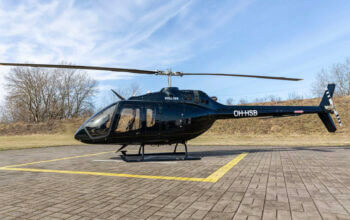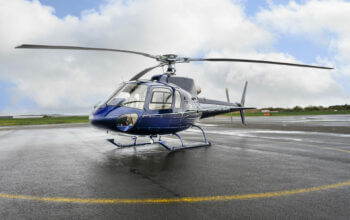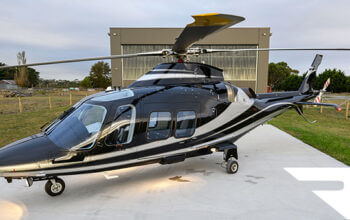Estimated reading time 6 minutes, 21 seconds.
A shorter version of the De Havilland Dash 8-400 is not the only variant under consideration for Longview Aviation Capital Corp.’s future production pipeline.

In a recent interview with Skies, Todd Young, chief operating officer for De Havilland Aircraft of Canada, a subsidiary of Longview, confirmed discussions were underway for modifications to the 400. “This would be a shorter aircraft in the range of 50 to 60 seats. That would be a possible replacement to the original Dash 8-300, albeit based on a Dash 8-400 configuration,” he said.
But Longview is unlikely to stop there, David Curtis, president and chief executive officer, told the Canadian Aerospace Summit last month. With no plans for a clean sheet design in the foreseeable future, the company strategy is solely focused on new variants of its recently acquired fleets of iconic aircraft.
“If there are not going to be any clean sheet designs … will there be variants? Absolutely,” he said.” Is there a cargo-carrying Shorts SD 330 Sherpa that has an aft door that will take five LD3 [containers] in it? Probably. Is there a variant on a Dash-8 400 that is maybe shorter? Maybe. Is there potential for another one of our single-engine turboprops to go back into production? For sure.”
As other manufacturers have divested their turboprop businesses, Victoria-based Longview has been keen to pounce, picking up the Canadair CL-215 and 415 amphibian business from Bombardier in 2016 and, more recently, the De Havilland brand from Bombardier in June 2019. At the same time, but with far less fanfare, it also acquired the type certificates for the Shorts SD-330 and SD-60 commuter turboprop aircraft previously built by Shorts in Belfast. The company now holds 14 aircraft designs and 23 distinct aircraft types.
“We have 23 certified aircraft – any one of which, as we have proven with the Twin Otter, could be modernized and put back into production,” said Curtis. “That is really where we see our future.”
The successful revival of the DHC-6 Twin Otter, which had been out of production since 1988, was one of the reasons for pursuing the De Havilland brand, he told an aerospace, defence and security trade show in Abbotsford, B.C., in August. Viking, part of the Longview portfolio, has produced 160 of the new 400 Series aircraft, which is now in operation in 27 countries.
“The Twin Otter is from the same DNA, so we understand the program,” he said. “We learned on a small scale about aircraft production, we learned about managing supply chain, we learned about obsolescence, recertification, modernization of older platforms.”
While the De Havilland Dash 8-400 program represents a much larger undertaking – the company was nervous about taking on another 1,400 employees and two unions at the Downsview facility in Toronto, admitted Curtis – the iconic name and its global recognition were too good to pass up.
“What we found was that the culture of the de Havilland brand, the people that we talked to as Bombardier allowed us to get more involved with the business, was truly incredible,” he said. “You find second-generation employees [whose] parents or grandfather worked at De Havilland. We really believe that we have got a huge opportunity to leverage that passion and commitment. We have an incredible opportunity to build a new, great Canadian OEM that is based on some incredible Canadian designs.”
Because Longview operates in a “low volume world,” selling its aircraft in small quantities, it’s well positioned to be an innovation leader, added Curtis, capitalizing on emerging technologies like hybrid electric propulsion and additive manufacturing.
Prophetically, he noted that turboprops are a logical platform for new engine systems. “That is where we think we will lead, with hybrid electric power. Many manufacturers are looking at it. I can tell you we are getting lots of phone calls.”
On Dec. 11, Harbour Air conducted the first test flight of a commercial aircraft, a de Havilland DHC-2 Beaver floatplane, powered by an advanced MagniX electric propulsion system.
Viking has already begun 3D printing legacy-designed parts for the Twin Otter as a way to address cost and weight, and will be investing further in the technology as it restarts production on a next generation CL-515 aerial firefighter and multirole amphibious aircraft.
“We’ve got a weight target reduction in the 3,000-pound range to lighten that airplane and additive is one of the channels by which we are going to do that. What that means is more water for firefighting,” he told the Canadian Aerospace Summit. “We see additive manufacturing as a path as to how we are going to change how we manufacture aircraft.”
The one barrier that could hinder the company’s growth is one most companies in the aerospace sector are confronting – talent retention and acquisition. Curtis noted that as many as 1,000 new employees might be needed to restart the CL-515 program.
“Getting 1,000 skilled aerospace folks in a very short period of time doesn’t happen overnight, so we see partnering with government and colleges and technical schools … [to] help us customize those training programs.”









The CL515 should be re-designed with a majority of composite materials for the primary structures. Massive weight savings and mitigation of corrosion issues will result if designed / assembled correctly.
The dirth of skilled workers can not be overcome by relying on the community college systems to educate and produce adequately trained Technicians, in the quantities & time required. Focused skills training by professionals in private institutes should be promoted rather than restricted be the provincial education ministries.